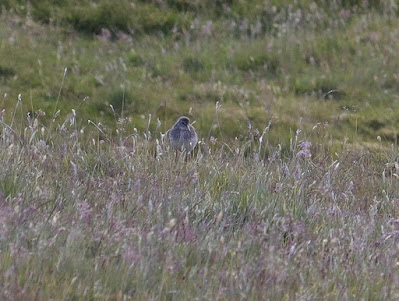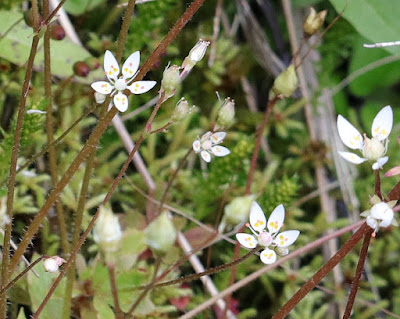Summer's height, and busy Spring has passed but on this day Autumn seems intent on a premature, gale riven rehearsal. A sheltered butt of heather makes a seat for my sketching effort as drifting light, cast from threatening cloud above, moves over moor and hill. Shadowy violet Bell heather now beacons bright magenta then back to darkness as hail splats a wet tune on dry sketch paper. Tiny fugitive snow balls roll over powdery pastel leaving their own artistic imprint until enough is enough and the whole lot is hurriedly shoved back into the rucksack.
 |
| Sketching today 2/7/23 |
Shadows of a different kind dart over these high Angus moors leaving a tracery of dark shapes on the ground as sunlight is occluded as they fly above. Swifts, by the score, entertain the billowing clouds and seem oblivious to the gale that swooshes o'er the heathery ridge above; the landscape is alive with movement. Heather slopes ripple like fields of Barley, and a meandering dribble of crystal water sparkles 'tween bog and burn where the nodding heads of Cottongrass, Creeping Thistle and Water Avens dwell.
 |
| Northern Eggar moth male 2/7/23 |
The moors give life to many insects, a bother to some but food to others and the Swifts take full advantage of a plentiful supply. Thin and curved back, their wings scythe through the air whilst hawking after every flying insect and then, when gullets are full, they vanish for a while. These birds are feeding chicks back in the lowland towns where they nest under the gutter slates of old houses. Strangely enough it has been recorded that Swifts in south England travel over the Channel and into France to forage for insects to feed chicks that incidentally enter a torpor phase when adults are away.
 |
| Heath Spotted-orchid 2/7/23 |
How quickly the months pass, June turns to July with a kiss and handshake on delivering up so many young birds to Mother Nature. Wheatears and Ring Ouzels seem to have done well this year for dozens of juveniles flit and chat o'er the moors. I spy young Curlews weaving through lanky grass and a young Redshank on passing its natal bog, and a young Lapwing that has already adopted the bow and ground peck of the adult birds when excited, but there is that sense of lull, of being over. Some waders have already vacated the pasture borders of the moor and the plaintive call of the Golden Plover is fading into next year, maybe.
 |
| Curlew juvenile 2/7/23 |
On days like this, when gales howl, my joy is knee deep in the steep, beflowered and tinkly gullies that cascade down the glen slopes. A Common Snipe jettisons itself up from a raft of Soft Rush and into the wind stream to zig-zag o'er the glen void so fast, and a bucketful of Water Avens bow their purple delicacy over a chandelier of cascading water, and in the shade of that cascade grow the erect stalks of Marsh Willowherb, and yellow flowered Marsh Hawk's-beard hangs from seeping crevasses. Below my feet a sodden bellyful of moss erupts with the sparkly flowers of Starry Saxifrage, and the bright blue ringlets of Water Forget-Me-Not dip their feet into any wet goo available.
 |
| Cottongrass 2/7/23 |
From these moorland sprinklings our soft water comes, and it is pure after percolating down through boggy peat then over oxygenating, algae coated sand and pebbles, then over beds of filtering moss multiple times over. The Golden Eagle likes this sheltered gully too and I find a sentry post rock near the waterfall where a Red Grouse has been plucked, a few preened feathers flutter in the draft and a pellet has been disgorged. Grouse are quiet at this time of year, not many flushing or calling and I suppose they have young poults at the moment to hide from predator wings and eyes; later, I find one on the track that will not reach the dinner plate this year.
 |
| Water Avens 2/7/23 |
Rarely photographed but often seen darting across the moors is the male Northern Eggar moth. Today one seeks a safe haven in our gully, the wings are bruised but the sculptured antennae are intact and ready to search out the paler female who only flies at dusk. A Vapourer moth caterpillar is a strange sort of beast decorated in a bristly hat of spines with what looks like two horns protruding from its head and one crawls onto me as I wade through rank heather; another hitch-hiker was the skinny Common Heath moth caterpillar whose bendy arch antics always entertain.
 |
| Bog Asphodel 2/7/23 |
The year rattles by and soon the deer stalking season will start and not long after that the grouse shoot season will commence its traditions on the Angus hills. Time will tell if some borderline grouse moors will survive future viability and already neighbouring Glen Prosen shooting estate has been sold on for forestry development. With many estates hopefully turning over a new leaf regarding raptor persecution I do wonder if they can survive a growing number of raptors and corvids foraging the moors.
 |
| Vapourer moth early instar 2/7/23 |
The Angus population of Golden Eagles is growing with new breeding territories, along with an increase in Red Kites and Common Buzzards hunting over grouse moors, therefore can an already depleted stock of grouse recuperate enough to ensure a future ..... well, I am uncertain of that and, in my opinion, from what I have seen over the past few years things do not look too good. The shooting community cannot have the 'gung-ho' attitudes of the past where 'good' money has been spent therefore that must guarantee a decent bag of grouse; certainly poor bags were a reason for a head-keeper to 'move on' in the past which only precipitated a new vigour regarding predator control on a replacement.
 |
| Red Admiral 2/7/23 |
A future with its own self determined balance will no doubt come about, but with the government scales of carbon justice biting at everyone's heels that balance must surely be to the detriment of grouse moor existence and biased in favour of wind-farms and tree planting; the sickly 'green' death of Scottish landscape is nigh.
 |
| Small Pearl-bordered Fritillary pairing 2/7/23 |
 |
| Redshank juv? 2/7/23 |
 |
| Golden Eagle's plucking perch 2/7/23 |
 |
| Wheatear juvenile flight 2/7/23 |
 |
| Wheatear juvenile 2/7/23 |
 |
| Starry Saxifrage 2/7/23 |
 |
| Ring Ouzel juvenile 2/7/23 |
 |
| Nice head ... Red Deer stag in antler velvet 2/7/23 |
 |
| Lapwing juvenile 2/7/23 |
 |
| Swift 2/7/23 |
 |
| Marsh Willowherb 2/7/23 |
 |
| Marsh Hawk's-beard 2/7/23 |
 |
| Small Heath 2/7/23 |
 |
| Red Grouse poult carcass 2/7/23 |
 |
| Bell Heather 2/7/23 |
 |
| Party balloon all the way from North Yorkshire to Angus |
All text, photographs and sketch done on 2 July 2023 (unless dated otherwise) and subject to copyright - no reproduction.
If you are inspired to go out into the hills and glens of Scotland please leave it as you find it, respect the environment, do not litter or discard so called 'biodegradable' fruit and especially if you are a dog walker keep your beast on a lead and do not bag up its waste then chuck it by the wayside. I recently came across one black poo bag neatly hung on a tree branch for someone else to take home and also a bright blue one thrown in the moorland verge .... why?
Moorland birds like Lapwing, Curlew, Golden Plover, Dunlin, Dotterel, Snipe, Red and Black Grouse, Ptarmigan and many raptors nest on the ground, it is advisable to keep dogs on leads at all times especially when walking on the high plateaux of the Cairngorms during summer months.
Please be aware that it is illegal to disturb nesting eagles or other raptors and you may do so inadvertently in your journeys into the highlands. Observe protected species at a respectful distance usually from about 1000 metres and for short periods of time only.
No wildlife was unduly or knowingly disturbed by my presence or for the purposes of this web page other than what would be expected on a normal hill walk. Many geographic names and location recognizable photos have been omitted to prevent persecution or inquisitive disturbance to named species.
Canon camera 200D with optical zoom lens EFS 55-250mm used; please note that the zoom range ZR distance if given is calculated by OS map from subject location to camera.


























